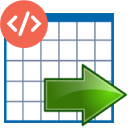Azure DevOps Connector for SSISAzure DevOps Connector can be used to integrate Azure DevOps data in your App / BI Tools. You can create, read, query, modify, and delete WorkItems, Projects, Teams and more. In this article you will learn how to quickly and efficiently integrate Azure DevOps data in SSIS without coding. We will use high-performance Azure DevOps Connector to easily connect to Azure DevOps and then access the data inside SSIS. Let's follow the steps below to see how we can accomplish that! Azure DevOps Connector for SSIS is based on ZappySys API Connector Framework which is a part of SSIS PowerPack. It is a collection of high-performance SSIS connectors that enable you to integrate data with virtually any data provider supported by SSIS, including SQL Server. SSIS PowerPack supports various file formats, sources and destinations, including REST/SOAP API, SFTP/FTP, storage services, and plain files, to mention a few (if you are new to SSIS and SSIS PowerPack, find out more on how to use them). |
Connect to Azure DevOps in other apps
|
Video Tutorial - Integrate Azure DevOps data in SSIS
This video covers the following topics and more, so please watch carefully. After watching the video, follow the steps outlined in this article:
- How to download and install the required PowerPack for
Azure DevOps integration in SSIS - How to configure the connection for
Azure DevOps - Features of the
ZappySys API Source (Authentication / Query Language / Examples / Driver UI) - How to use the
Azure DevOps in SSIS
Prerequisites
Before we begin, make sure the following prerequisites are met:
- SSIS designer installed. Sometimes it is referred as BIDS or SSDT (download it from Microsoft).
- Basic knowledge of SSIS package development using Microsoft SQL Server Integration Services.
- SSIS PowerPack is installed (if you are new to SSIS PowerPack, then get started!).
Read data from Azure DevOps in SSIS (Export data)
In this section we will learn how to configure and use Azure DevOps Connector in API Source to extract data from Azure DevOps.
-
Begin with opening Visual Studio and Create a New Project.
Select Integration Service Project and in new project window set the appropriate name and location for project. And click OK.
-
In the new SSIS project screen you will find the following:
- SSIS ToolBox on left side bar
- Solution Explorer and Property Window on right bar
- Control flow, data flow, event Handlers, Package Explorer in tab windows
- Connection Manager Window in the bottom
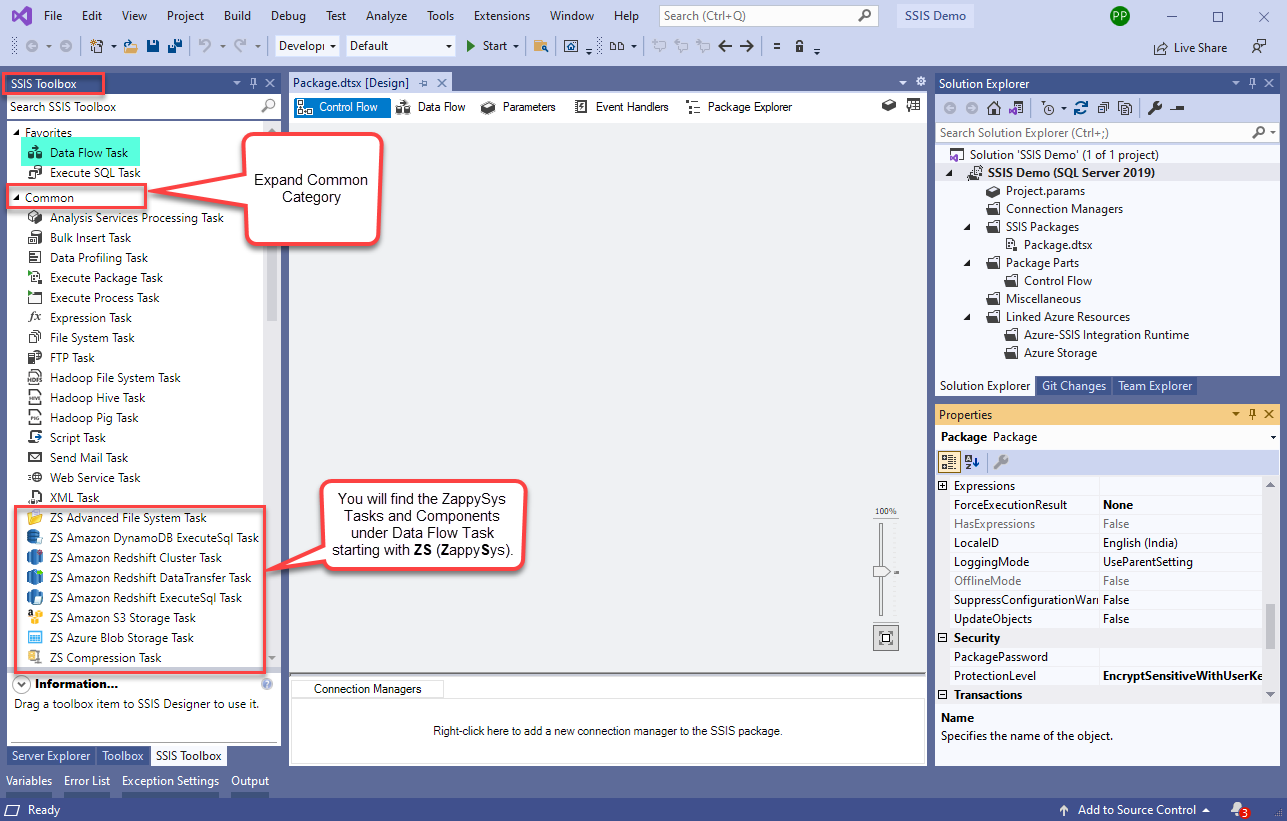 Note: If you don't see ZappySys SSIS PowerPack Task or Components in SSIS Toolbox, please refer to this help link.
Note: If you don't see ZappySys SSIS PowerPack Task or Components in SSIS Toolbox, please refer to this help link. -
Now, Drag and Drop SSIS Data Flow Task from SSIS Toolbox. Double click on the Data Flow Task to see Data Flow designer.

-
From the SSIS toolbox drag and API Source (Predefined Templates) on the data flow designer surface, and double click on it to edit it:
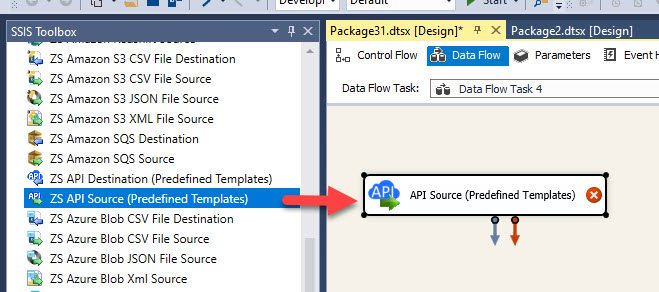
-
Select New Connection to create a new connection:
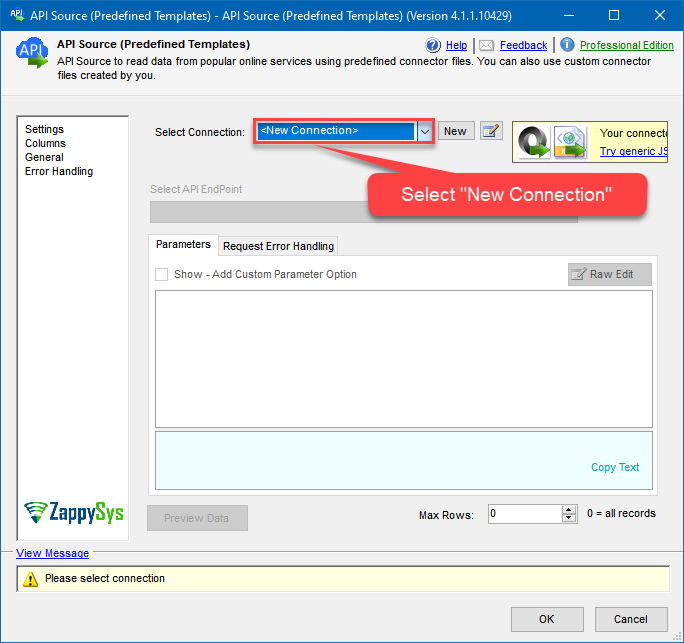
-
Use a preinstalled Azure DevOps Connector from Popular Connector List or press Search Online radio button to download Azure DevOps Connector. Once downloaded simply use it in the configuration:
Azure DevOps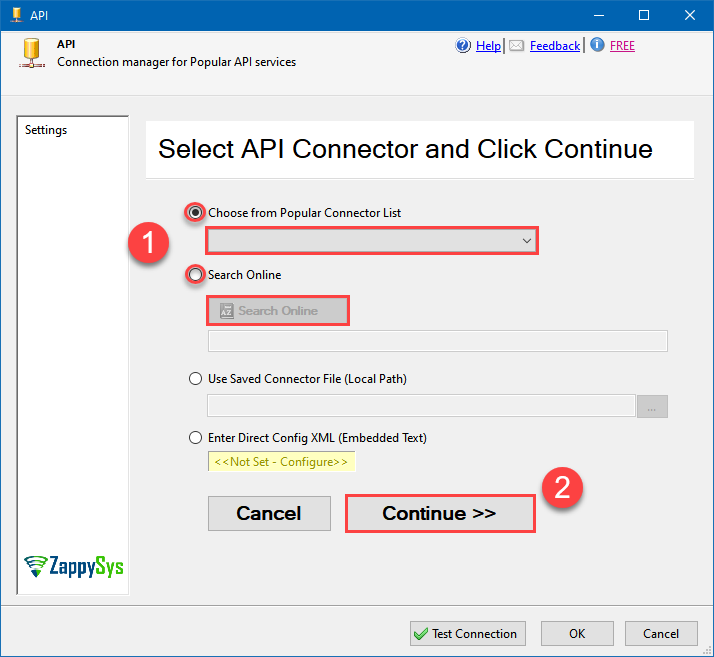
-
Proceed with selecting the desired Authentication Type. Then select API Base URL (in most cases default one is the right one). Finally, fill in all the required parameters and set optional parameters if needed. You may press a link Steps to Configure which will help set certain parameters. More info is available in Authentication section.
Steps how to get and use Azure DevOps credentials
Connecting to your Azure DevOps data requires you to authenticate your REST API access. Follow the instructions below:- Go to https://app.vsaex.visualstudio.com/app/register to register your app.
-
Fill in your application and company's information as required, and then select the scopes that your application needs.
This should typically be Project and team (read and write) and Work items (read and write).
Your selected scopes when registering your app must match the scopes you enter here on the connector screen. If they don't match, the connector will not be able to work with your Azure DevOps account!If you need further information about the scopes used in Azure DevOps, or need to see what to enter into the connector screen to match up with your selected scopes, visit https://learn.microsoft.com/en-us/azure/devops/integrate/get-started/authentication/oauth?view=azure-devops.
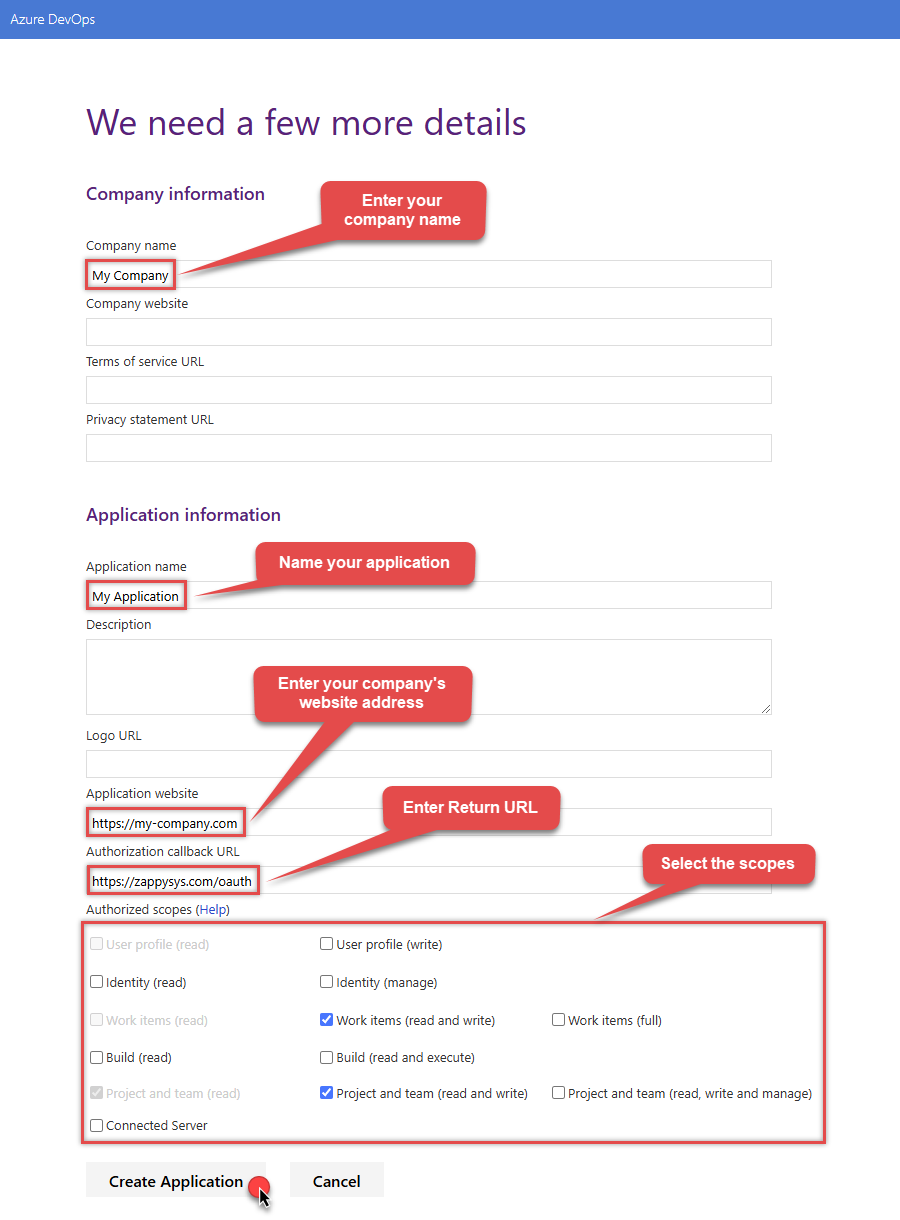
NOTE: For Authorization callback URL use your company's OAuth Redirect URL (if IT administrator provides you one) or you can use
https://zappysys.com/oauth(it's safe). - Select Create Application and then the Application Settings page will be displayed.
-
Record the App ID for us to use later:
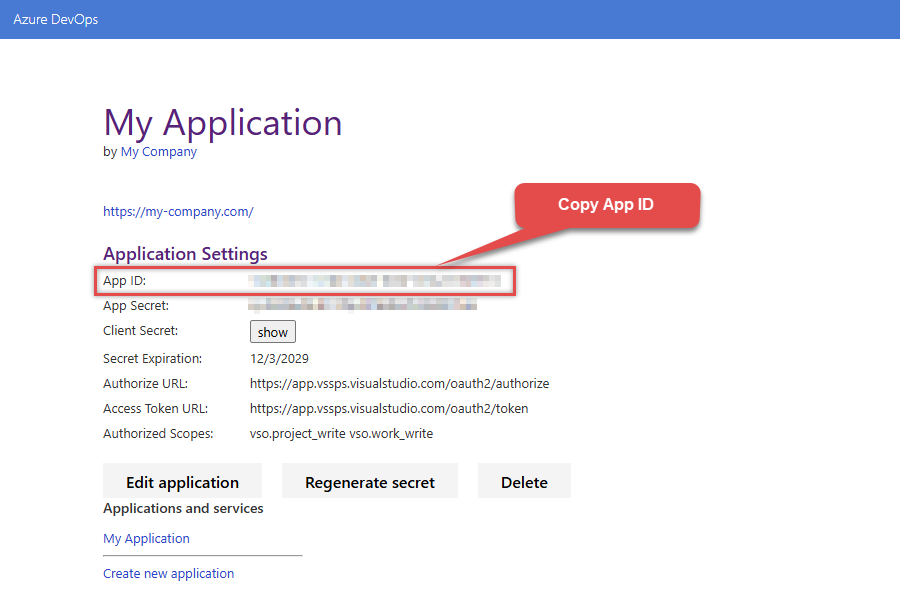
-
And do the same with Client Secret:
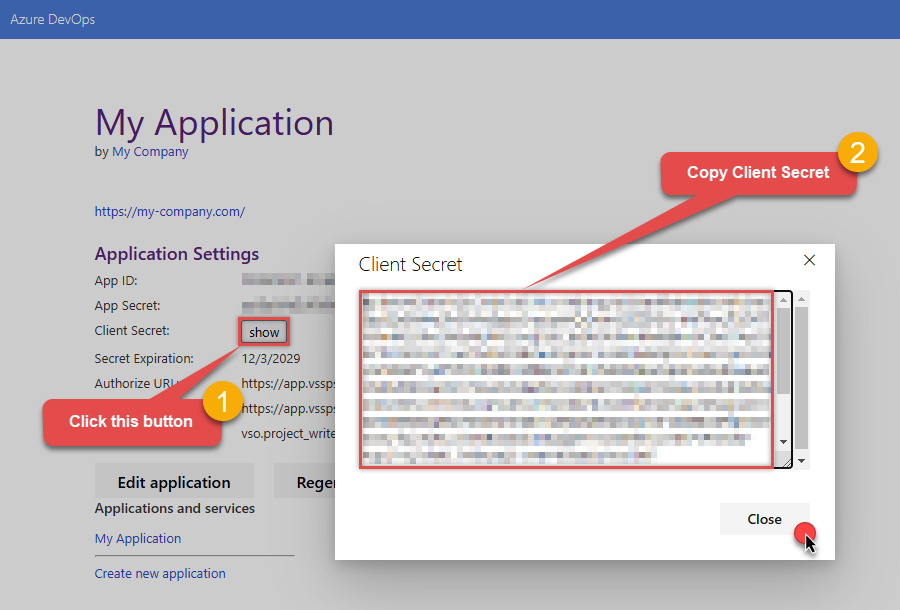
- Then go to https://aex.dev.azure.com and select relevant organization on the left.
-
Then copy Organization's host name part (e.g.
acmeinc, if full host name isacmeinc.visualstudio.com), save it to a file, and click it: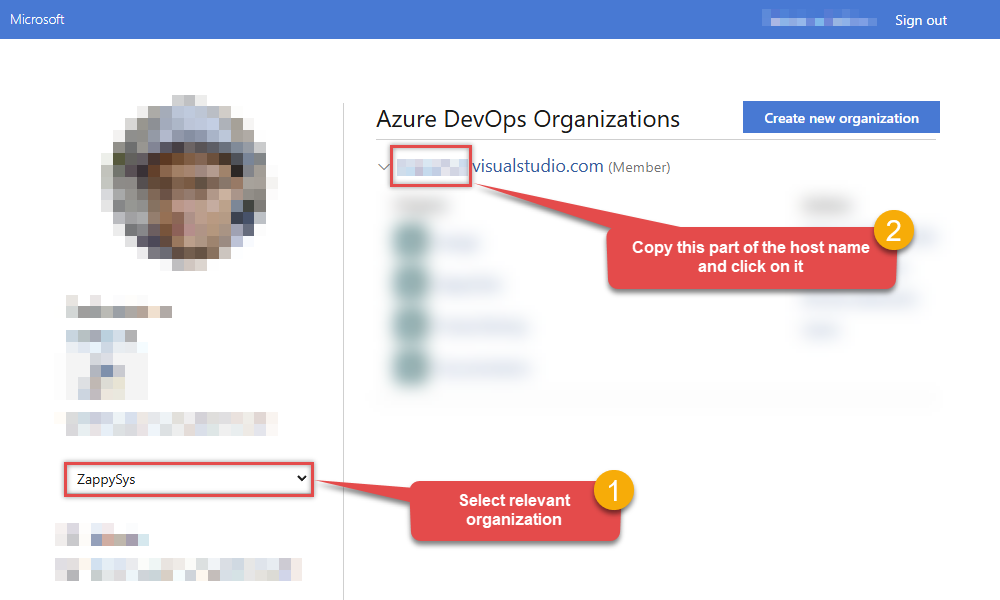
- Back at the connector screen, enter the App ID into the Client Id (App ID) field that was recorded in the previous step.
- Enter the Client Secret that was recorded in the previous step into the Client Secret field. In order to edit the text in this field, select the ellipses (...) button that appears when the textbox is clicked, and edit the Client Secret with the dialog box that appears.
- Enter the organization that was recorded in step 5 into the Organization name or Id for url field.
- Click Generate Token. If proper authentication occurs, you will see a notice saying so. You can click Yes to save a backup file of your generated tokens.
- Select the project you want to connect to by default from the Default Project (Choose after Generating Token) field.
- Select the Security tab.
-
Enter
https://auditservice.dev.azure.com,https://almsearch.dev.azure.cominto the Additional Trusted Domains field. - Select the Test Connection button at the bottom of the window to verify proper connectivity with your Azure DevOps account.
- If the connection test succeeds, select OK.
-
To edit previously created app you can visit
https://app.vsaex.visualstudio.com/meand see Applications and services section. Click on your desired app name.
Configuring authentication parameters
Azure DevOpsOAuth [OAuth]https://dev.azure.comRequired Parameters Client Id (App ID) Fill-in the parameter... Client Secret Fill-in the parameter... Organization name or Id for url (e.g. mycompany) Fill-in the parameter... Return URL Fill-in the parameter... Scopes (Must match with App Registration) Fill-in the parameter... API Version Fill-in the parameter... Optional Parameters Default Project Name (Choose after Generating Token) RetryMode RetryWhenStatusCodeMatch RetryStatusCodeList 429 RetryCountMax 5 RetryMultiplyWaitTime True 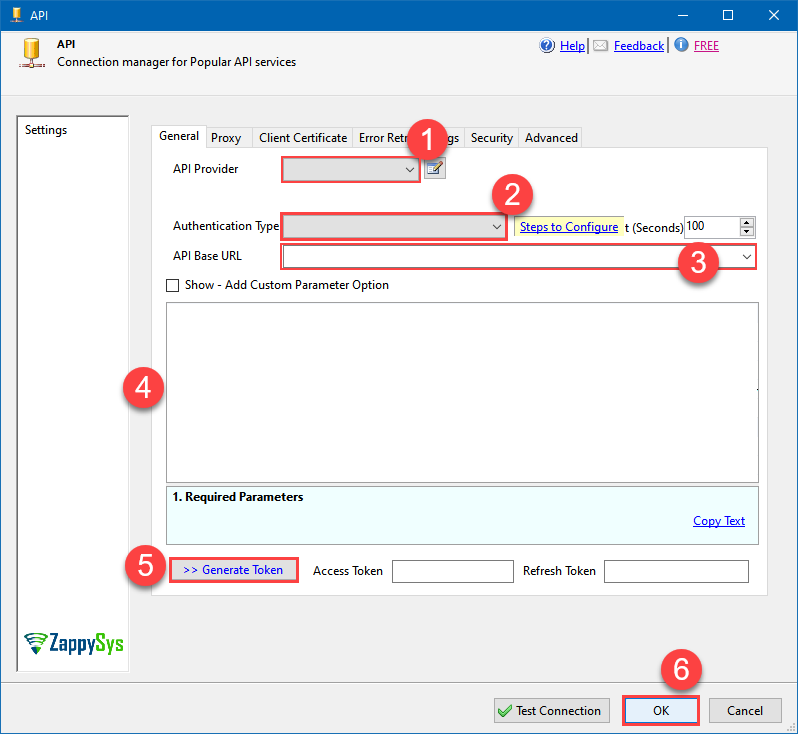 Steps how to get and use Azure DevOps credentials
Steps how to get and use Azure DevOps credentials
To connect to Azure DevOps using a Personal Access Token (PAT), you must first create a valid PAT:- Start by by going to https://aex.dev.azure.com and selecting relevant organization on the left.
-
Then copy Organization's host name part (e.g.
acmeinc, if full host name isacmeinc.visualstudio.com), save it to a file, and click it:
-
Next, click User settings icon and then click Personal access tokens:
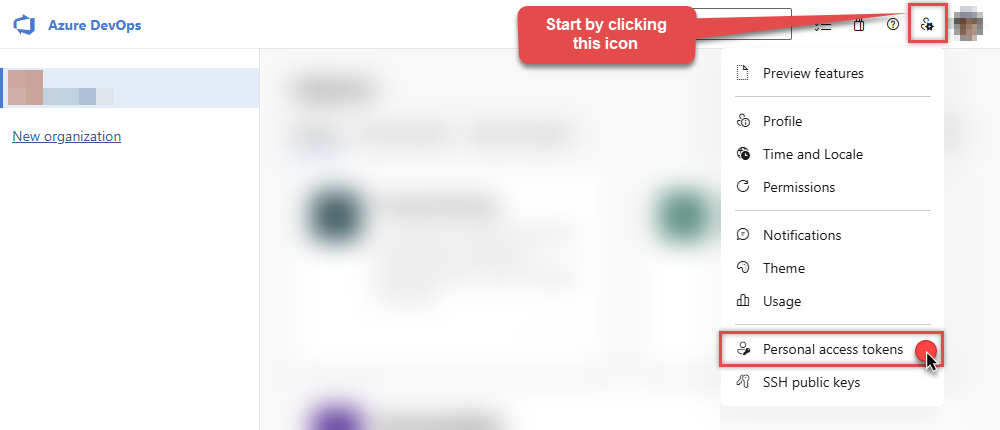
-
Then click New Token button to create a new personal access token:

-
Continue by...
- naming your token
- selecting the right Organization
- setting token's Expiration date (it's recommended to use
Custom definedoption and make it expire after one year or later) - and setting the Scopes:
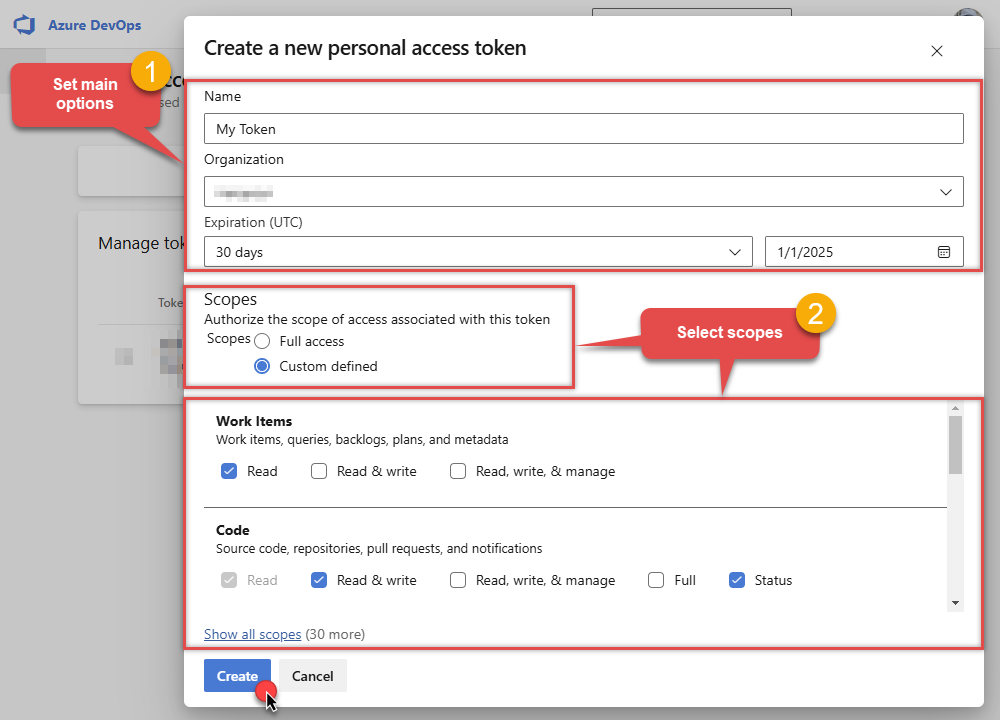
NOTE: You may be restricted from creating full-scoped PATs. If so, your Azure DevOps administrator in Azure AD has enabled a policy which limits you to a specific custom defined set of scopes.
-
Now click Copy button and save the newly created token into a file for quick access later:
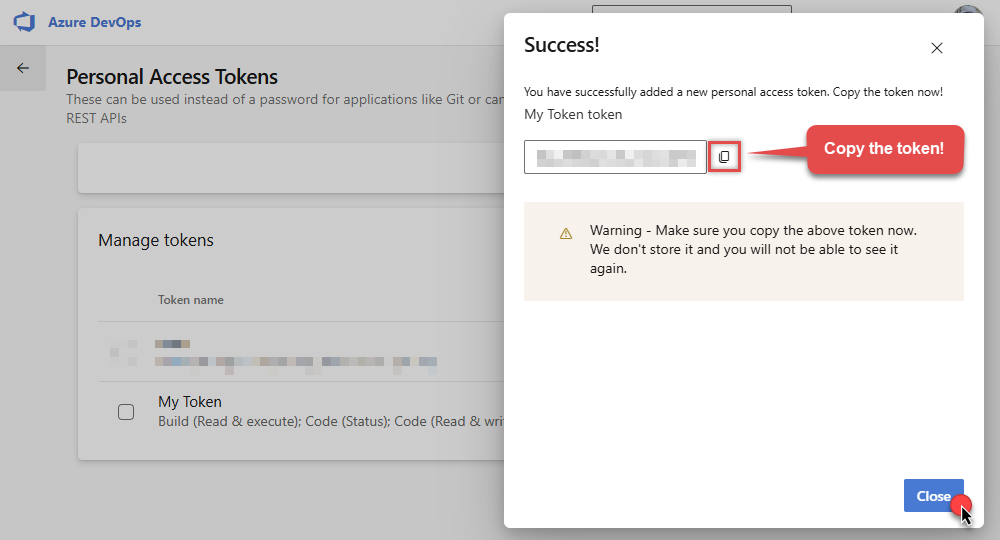
- Go back to the connector screen, input the token you saved in a previous step into the Personal Access Token (PAT) field.
- Then enter the Organization host name part that you noted recorded in previous step into Organization name or Id for url field.
- Enter the name or Id of the project you want to connect to by default in the Default Project (Choose after above fields) field.
- Select the Security tab.
- Enter
https://auditservice.dev.azure.com,https://almsearch.dev.azure.com,https://analytics.dev.azure.cominto the Additional Trusted Domains field. - Select the Test Connection button at the bottom of the window to verify proper connectivity with your Azure DevOps account.
- Done!
Configuring authentication parameters
Azure DevOpsPersonal Access Token (PAT) [Http]https://dev.azure.comRequired Parameters Personal Access Token (PAT) Fill-in the parameter... Organization name or Id for url Fill-in the parameter... API Version Fill-in the parameter... Optional Parameters AuthScheme Bearer AuthHeader Authorization UserName Default Project Name (Choose after Generating Token) RetryMode RetryWhenStatusCodeMatch RetryStatusCodeList 429 RetryCountMax 5 RetryMultiplyWaitTime True 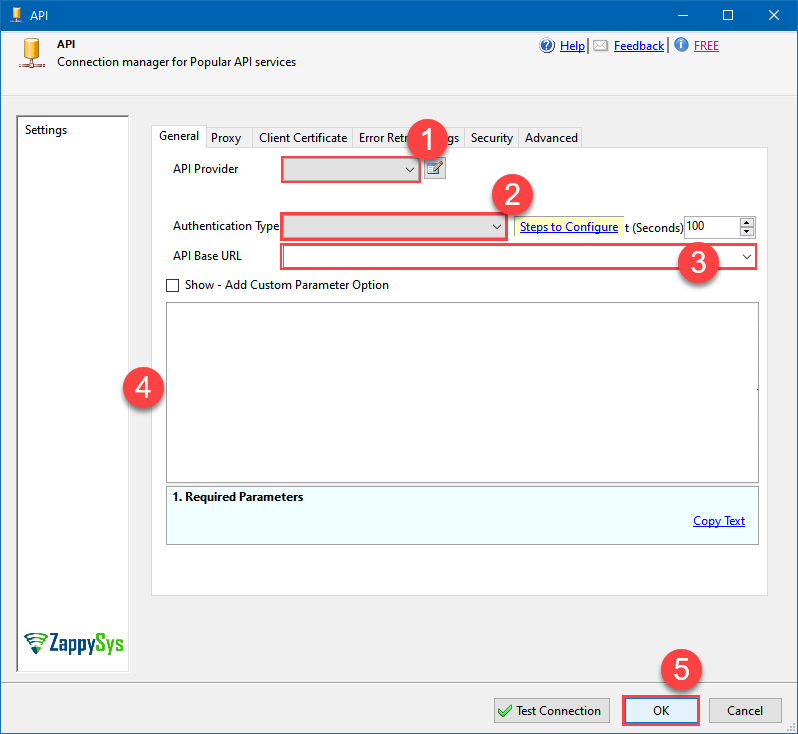
-
Select the desired endpoint, change/pass the properties values, and click on Preview Data button to make the API call.
API Source - Azure DevOpsAzure DevOps Connector can be used to integrate Azure DevOps data in your App / BI Tools. You can create, read, query, modify, and delete WorkItems, Projects, Teams and more.
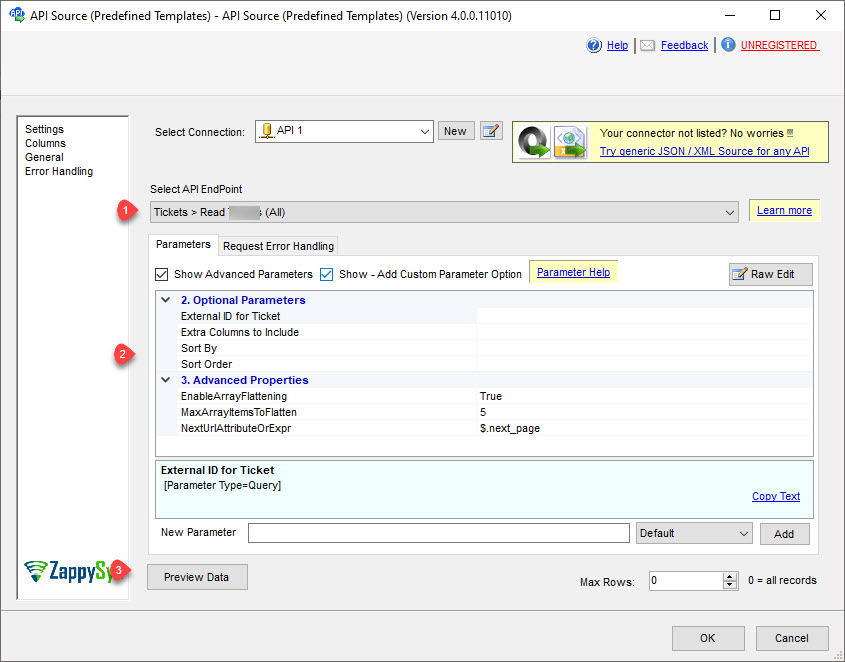
-
That's it! We are done! Just in a few clicks we configured the call to Azure DevOps using Azure DevOps Connector.
You can load the source data into your desired destination using the Upsert Destination, which supports SQL Server, PostgreSQL, and Amazon Redshift. We also offer other destinations such as CSV, Excel, Azure Table, Salesforce, and more. You can check out our SSIS PowerPack Tasks and components for more options. (*loaded in Trash Destination)
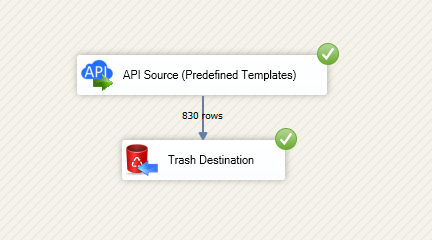
Write data to Azure DevOps using SSIS (Import data)
In this section we will learn how to configure and use Azure DevOps Connector in the API Destination to write data to Azure DevOps.
Video tutorial
This video covers following and more so watch carefully. After watching this video follow the steps described in this article.
- How to download SSIS PowerPack for
Azure DevOps integration in SSIS - How to configure connection for
Azure DevOps - How to write or lookup data to
Azure DevOps - Features about SSIS API Destination
- Using
Azure DevOps Connector in SSIS
Step-by-step instructions
In upper section we learned how to read data, now in this section we will learn how to configure Azure DevOps in the API Source to POST data to the Azure DevOps.
-
Read the data from the source, being any desired source component. In example we will use ZappySys Dummy Data Source component.
-
From the SSIS Toolbox drag and drop API Destination (Predefined Templates) on the Data Flow Designer surface and connect source component with it, and double click to edit it.
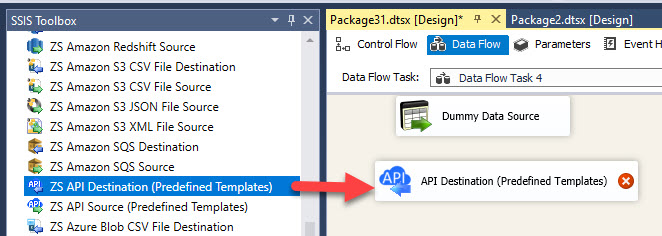
-
Select New Connection to create a new connection:
API Destination - Azure DevOpsAzure DevOps Connector can be used to integrate Azure DevOps data in your App / BI Tools. You can create, read, query, modify, and delete WorkItems, Projects, Teams and more.
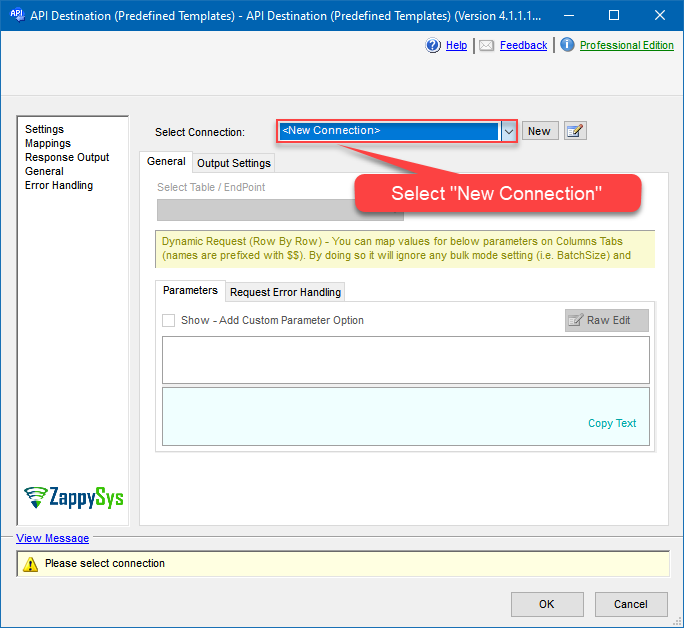
-
Use a preinstalled Azure DevOps Connector from Popular Connector List or press Search Online radio button to download Azure DevOps Connector. Once downloaded simply use it in the configuration:
Azure DevOps
-
Proceed with selecting the desired Authentication Type. Then select API Base URL (in most cases default one is the right one). Finally, fill in all the required parameters and set optional parameters if needed. You may press a link Steps to Configure which will help set certain parameters. More info is available in Authentication section.
Steps how to get and use Azure DevOps credentials
Connecting to your Azure DevOps data requires you to authenticate your REST API access. Follow the instructions below:- Go to https://app.vsaex.visualstudio.com/app/register to register your app.
-
Fill in your application and company's information as required, and then select the scopes that your application needs.
This should typically be Project and team (read and write) and Work items (read and write).
Your selected scopes when registering your app must match the scopes you enter here on the connector screen. If they don't match, the connector will not be able to work with your Azure DevOps account!If you need further information about the scopes used in Azure DevOps, or need to see what to enter into the connector screen to match up with your selected scopes, visit https://learn.microsoft.com/en-us/azure/devops/integrate/get-started/authentication/oauth?view=azure-devops.

NOTE: For Authorization callback URL use your company's OAuth Redirect URL (if IT administrator provides you one) or you can use
https://zappysys.com/oauth(it's safe). - Select Create Application and then the Application Settings page will be displayed.
-
Record the App ID for us to use later:

-
And do the same with Client Secret:

- Then go to https://aex.dev.azure.com and select relevant organization on the left.
-
Then copy Organization's host name part (e.g.
acmeinc, if full host name isacmeinc.visualstudio.com), save it to a file, and click it:
- Back at the connector screen, enter the App ID into the Client Id (App ID) field that was recorded in the previous step.
- Enter the Client Secret that was recorded in the previous step into the Client Secret field. In order to edit the text in this field, select the ellipses (...) button that appears when the textbox is clicked, and edit the Client Secret with the dialog box that appears.
- Enter the organization that was recorded in step 5 into the Organization name or Id for url field.
- Click Generate Token. If proper authentication occurs, you will see a notice saying so. You can click Yes to save a backup file of your generated tokens.
- Select the project you want to connect to by default from the Default Project (Choose after Generating Token) field.
- Select the Security tab.
-
Enter
https://auditservice.dev.azure.com,https://almsearch.dev.azure.cominto the Additional Trusted Domains field. - Select the Test Connection button at the bottom of the window to verify proper connectivity with your Azure DevOps account.
- If the connection test succeeds, select OK.
-
To edit previously created app you can visit
https://app.vsaex.visualstudio.com/meand see Applications and services section. Click on your desired app name.
Configuring authentication parameters
Azure DevOpsOAuth [OAuth]https://dev.azure.comRequired Parameters Client Id (App ID) Fill-in the parameter... Client Secret Fill-in the parameter... Organization name or Id for url (e.g. mycompany) Fill-in the parameter... Return URL Fill-in the parameter... Scopes (Must match with App Registration) Fill-in the parameter... API Version Fill-in the parameter... Optional Parameters Default Project Name (Choose after Generating Token) RetryMode RetryWhenStatusCodeMatch RetryStatusCodeList 429 RetryCountMax 5 RetryMultiplyWaitTime True  Steps how to get and use Azure DevOps credentials
Steps how to get and use Azure DevOps credentials
To connect to Azure DevOps using a Personal Access Token (PAT), you must first create a valid PAT:- Start by by going to https://aex.dev.azure.com and selecting relevant organization on the left.
-
Then copy Organization's host name part (e.g.
acmeinc, if full host name isacmeinc.visualstudio.com), save it to a file, and click it:
-
Next, click User settings icon and then click Personal access tokens:

-
Then click New Token button to create a new personal access token:

-
Continue by...
- naming your token
- selecting the right Organization
- setting token's Expiration date (it's recommended to use
Custom definedoption and make it expire after one year or later) - and setting the Scopes:

NOTE: You may be restricted from creating full-scoped PATs. If so, your Azure DevOps administrator in Azure AD has enabled a policy which limits you to a specific custom defined set of scopes.
-
Now click Copy button and save the newly created token into a file for quick access later:

- Go back to the connector screen, input the token you saved in a previous step into the Personal Access Token (PAT) field.
- Then enter the Organization host name part that you noted recorded in previous step into Organization name or Id for url field.
- Enter the name or Id of the project you want to connect to by default in the Default Project (Choose after above fields) field.
- Select the Security tab.
- Enter
https://auditservice.dev.azure.com,https://almsearch.dev.azure.com,https://analytics.dev.azure.cominto the Additional Trusted Domains field. - Select the Test Connection button at the bottom of the window to verify proper connectivity with your Azure DevOps account.
- Done!
Configuring authentication parameters
Azure DevOpsPersonal Access Token (PAT) [Http]https://dev.azure.comRequired Parameters Personal Access Token (PAT) Fill-in the parameter... Organization name or Id for url Fill-in the parameter... API Version Fill-in the parameter... Optional Parameters AuthScheme Bearer AuthHeader Authorization UserName Default Project Name (Choose after Generating Token) RetryMode RetryWhenStatusCodeMatch RetryStatusCodeList 429 RetryCountMax 5 RetryMultiplyWaitTime True 
-
Select the desired endpoint, change/pass the properties values, and go to the Mappings tab to map the columns.
API Destination - Azure DevOpsAzure DevOps Connector can be used to integrate Azure DevOps data in your App / BI Tools. You can create, read, query, modify, and delete WorkItems, Projects, Teams and more.
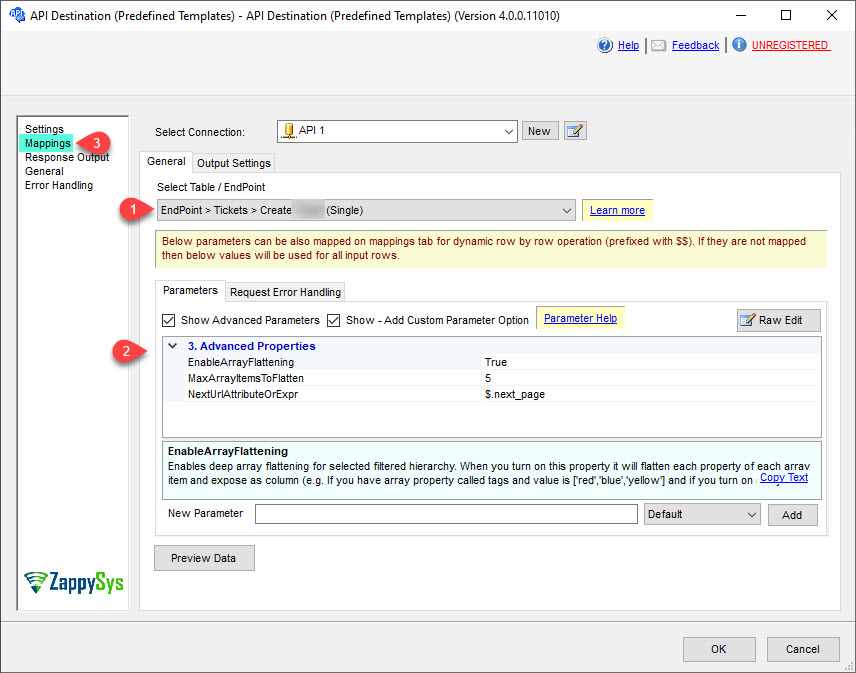
-
Finally, map the desired columns:
API Destination - Azure DevOpsAzure DevOps Connector can be used to integrate Azure DevOps data in your App / BI Tools. You can create, read, query, modify, and delete WorkItems, Projects, Teams and more.
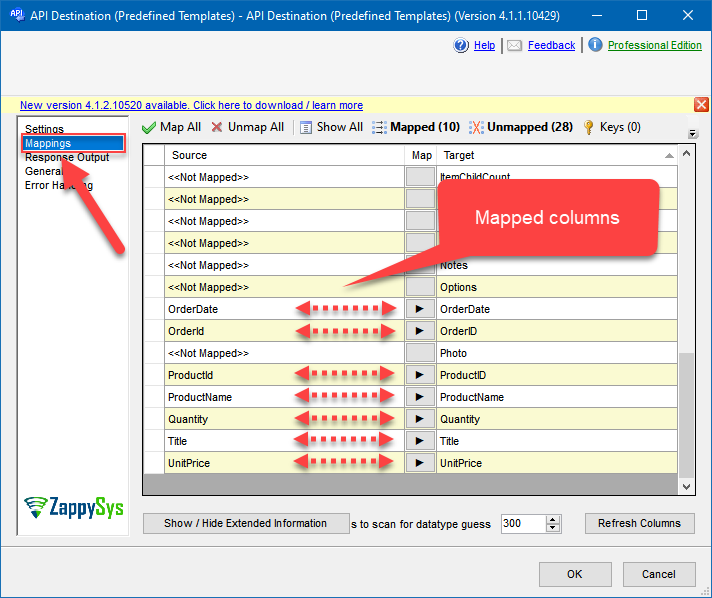
-
That's it; we successfully configured the POST API Call. In a few clicks we configured the Azure DevOps API call using ZappySys Azure DevOps Connector
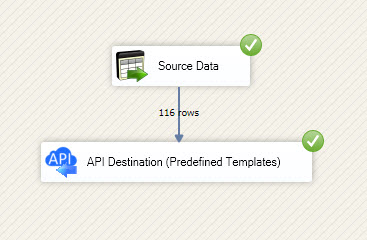
Load Azure DevOps data into SQL Server using Upsert Destination (Insert or Update)
Once you configured the data source, you can load Azure DevOps data into SQL Server using Upsert Destination.
Upsert Destination can merge or synchronize source data with the target table.
It supports Microsoft SQL Server, PostgreSQL, and Redshift databases as targets.
Upsert Destination also supports very fast bulk upsert operation along with bulk delete.
Upsert operation
- a database operation which performs INSERT or UPDATE SQL commands
based on record's existence condition in the target table.
It
Upsert Destination supports INSERT, UPDATE, and DELETE operations,
so it is similar to SQL Server's MERGE command, except it can be used directly in SSIS package.
-
From the SSIS Toolbox drag-and-drop Upsert Destination component onto the Data Flow designer background.
-
Connect your SSIS source component to Upsert Destination.
-
Double-click on Upsert Destination component to open configuration window.
-
Start by selecting the Action from the list.
-
Next, select the desired target connection or create one by clicking <New [provider] Connection> menu item from the Target Connection dropdown.
-
Then select a table from the Target Table list or click New button to create a new table based on the source columns.
-
Continue by checking Insert and Update options according to your scenario (e.g. if Update option is unchecked, no updates will be made).
-
Finally, click Map All button to map all columns and then select the Key columns to match the columns on:
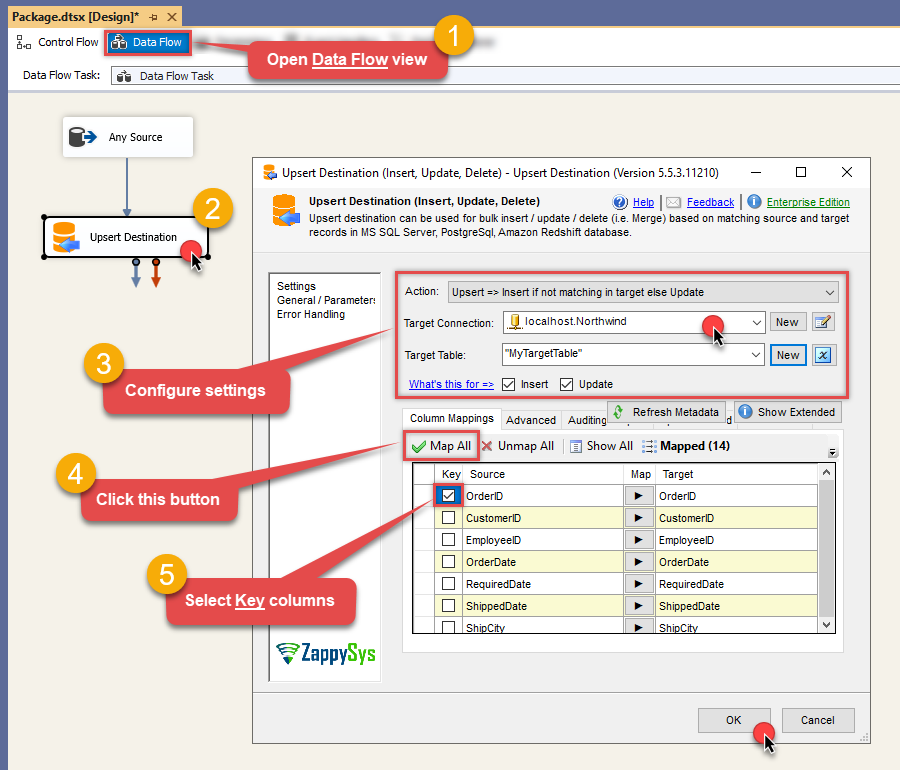
-
Click OK to save the configuration.
-
Run the package and Azure DevOps data will be merged with the target table in SQL Server, PostgreSQL, or Redshift:
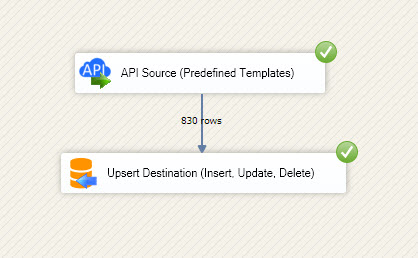
-
Done!
Deploy and schedule SSIS package
After you are done creating SSIS package, most likely, you want to deploy it to SQL Server Catalog and run it periodically. Just follow the instructions in this article:
Running SSIS package in Azure Data Factory (ADF)
To use SSIS PowerPack in ADF, you must first prepare Azure-SSIS Integration Runtime. Follow this link for detailed instructions:
Advanced topics
Actions supported by Azure DevOps Connector
Azure DevOps Connector support following actions for REST API integration. If some actions are not listed below then you can easily edit Connector file and enhance out of the box functionality.| Parameter | Description | ||||||
|---|---|---|---|---|---|---|---|
| Project Name |
|
||||||
| Team Id or Name |
|
||||||
| Use time precision |
|
||||||
| Wiql Query |
|
| Parameter | Description | ||||||
|---|---|---|---|---|---|---|---|
| Project Name |
|
||||||
| Query Id |
|
||||||
| Team Id or Name |
|
||||||
| Use time precision |
|
| Parameter | Description | ||||||
|---|---|---|---|---|---|---|---|
| Project Name |
|
||||||
| Team Id or Name |
|
||||||
| Use time precision |
|
||||||
| Wiql Query |
|
| Parameter | Description | ||||||
|---|---|---|---|---|---|---|---|
| Project Name |
|
||||||
| Team Id or Name |
|
||||||
| Use time precision |
|
||||||
| Wiql Query |
|
| Parameter | Description |
|---|---|
| WorkItemId |
|
| Project Name |
|
| api-version |
|
| Parameter | Description |
|---|---|
| Id |
|
| WorkItemId |
|
| Project Name |
|
| api-version |
|
| Parameter | Description |
|---|---|
| Id |
|
| WorkItemId |
|
| Project Name |
|
| Comment Text |
|
| api-version |
|
| Parameter | Description |
|---|---|
| Id |
|
| WorkItemId |
|
| Project Name |
|
| Comment Text |
|
| api-version |
|
| Parameter | Description |
|---|---|
| Id |
|
| WorkItemId |
|
| Project Name |
|
| api-version |
|
| Parameter | Description | ||||||||||||
|---|---|---|---|---|---|---|---|---|---|---|---|---|---|
| Project Name |
|
||||||||||||
| Expand Parameters |
|
| Parameter | Description | ||||||||||||
|---|---|---|---|---|---|---|---|---|---|---|---|---|---|
| Project Name |
|
||||||||||||
| Work Item Id List (comma separated) |
|
||||||||||||
| As-Of Date |
|
||||||||||||
| Expand Parameters |
|
||||||||||||
| Error Policy |
|
||||||||||||
| Fields |
|
| Parameter | Description |
|---|---|
| Project Name |
|
| Parameter | Description | ||||||
|---|---|---|---|---|---|---|---|
| Project Name |
|
||||||
| WorkItemType |
|
||||||
| ByPassRules |
|
| Parameter | Description | ||||||||||||||
|---|---|---|---|---|---|---|---|---|---|---|---|---|---|---|---|
| Project Name |
|
||||||||||||||
| Work Item Id |
|
||||||||||||||
| Operation |
|
| Parameter | Description |
|---|---|
| Project Name |
|
| Work Item Id |
|
| Parameter | Description |
|---|---|
| Project Name |
|
| Max Depth (items inside nested folders) |
|
| Parameter | Description |
|---|---|
| Id |
|
| Parameter | Description |
|---|---|
| Project Id |
|
| Parameter | Description |
|---|---|
| Project Id |
|
| Parameter | Description |
|---|---|
| Project Name |
|
| Parameter | Description | ||||||
|---|---|---|---|---|---|---|---|
| API Version |
|
||||||
| Team Id or Name |
|
||||||
| Project Name |
|
| Parameter | Description | ||||||
|---|---|---|---|---|---|---|---|
| API Version |
|
||||||
| Team Id |
|
| Parameter | Description | ||||||
|---|---|---|---|---|---|---|---|
| API Version |
|
||||||
| Team Id |
|
| Parameter | Description |
|---|---|
| Text to Search For |
|
| Parameter | Description | ||||||
|---|---|---|---|---|---|---|---|
| API Version |
|
||||||
| Project Name |
|
||||||
| Team Id or Name |
|
| Parameter | Description | ||||||
|---|---|---|---|---|---|---|---|
| API Version |
|
||||||
| Project Name |
|
||||||
| Team Id or Name |
|
| Parameter | Description | ||||||
|---|---|---|---|---|---|---|---|
| Project Name |
|
||||||
| Team Id or Name |
|
||||||
| Itertation Id or Name |
|
||||||
| API Version |
|
| Parameter | Description | ||||||||||||||||||||||||||
|---|---|---|---|---|---|---|---|---|---|---|---|---|---|---|---|---|---|---|---|---|---|---|---|---|---|---|---|
| Url |
|
||||||||||||||||||||||||||
| Body |
|
||||||||||||||||||||||||||
| IsMultiPart |
|
||||||||||||||||||||||||||
| Filter |
|
||||||||||||||||||||||||||
| Headers |
|
| Parameter | Description |
|---|---|
| Url |
|
| IsMultiPart |
|
| Filter |
|
| Headers |
|
Conclusion
In this article we showed you how to connect to Azure DevOps in SSIS and integrate data without any coding, saving you time and effort. It's worth noting that ZappySys API Driver allows you to connect not only to Azure DevOps, but to any Java application that supports JDBC (just use a different JDBC driver and configure it appropriately).
We encourage you to download Azure DevOps Connector for SSIS and see how easy it is to use it for yourself or your team.
If you have any questions, feel free to contact ZappySys support team. You can also open a live chat immediately by clicking on the chat icon below.
Download Azure DevOps Connector for SSIS Documentation
More integrations
Other connectors for SSIS
Other application integration scenarios for Azure DevOps
How to connect Azure DevOps in SSIS?
How to get Azure DevOps data in SSIS?
How to read Azure DevOps data in SSIS?
How to load Azure DevOps data in SSIS?
How to import Azure DevOps data in SSIS?
How to pull Azure DevOps data in SSIS?
How to push data to Azure DevOps in SSIS?
How to write data to Azure DevOps in SSIS?
How to POST data to Azure DevOps in SSIS?
Call Azure DevOps API in SSIS
Consume Azure DevOps API in SSIS
Azure DevOps SSIS Automate
Azure DevOps SSIS Integration
Integration Azure DevOps in SSIS
Consume real-time Azure DevOps data in SSIS
Consume real-time Azure DevOps API data in SSIS
Azure DevOps ODBC Driver | ODBC Driver for Azure DevOps | ODBC Azure DevOps Driver | SSIS Azure DevOps Source | SSIS Azure DevOps Destination
Connect Azure DevOps in SSIS
Load Azure DevOps in SSIS
Load Azure DevOps data in SSIS
Read Azure DevOps data in SSIS
Azure DevOps API Call in SSIS

























































